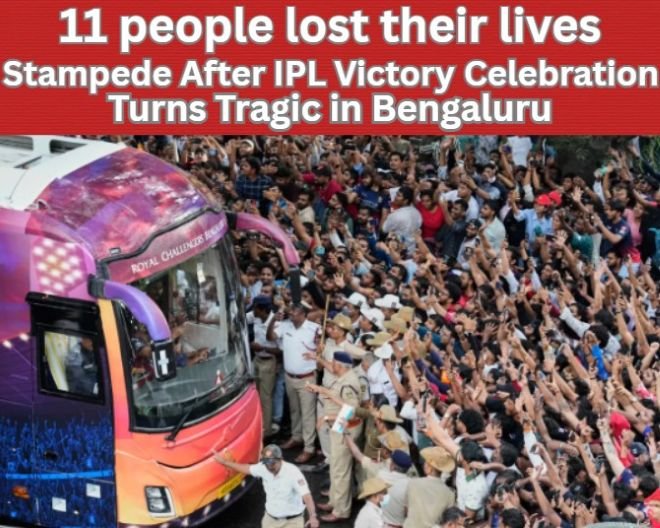Bengaluru’s jubilant celebrations following a major cricket victory turned into a tragic nightmare as stampedes at two separate locations reportedly claimed at least 11 lives. The mass gathering, which was meant to felicitate the triumphant team after their maiden league title, quickly spiraled out of control due to overwhelming crowd pressure and insufficient on-ground arrangements.
The chaos initially erupted outside a prominent stadium where thousands had gathered for a public felicitation ceremony organized by the state cricket association. Later, further disorder broke out on the grounds of the state legislative complex, where the players were taken to meet top state leaders. Both locations saw frenzied crowds pushing past barricades, climbing trees, and crowding rooftops in an effort to catch a glimpse of their cricketing heroes.
Crowd Control Failure Turns Celebration Into Tragedy
What began as a moment of pride for the city ended in panic as people fainted, lost consciousness, and were injured in the melee. Emergency visuals showed injured individuals being rushed to nearby hospitals. Eyewitness accounts described harrowing scenes of people gasping for breath amid the uncontrolled crowd crush.
The administration, while expressing regret, admitted to being overwhelmed by the turnout, which reportedly reached several lakhs. Despite deploying more than 5,000 personnel for crowd control, the planning and coordination proved insufficient. Key officials acknowledged that the energy of the young, enthusiastic crowd made it difficult to enforce standard control measures, and security forces were reluctant to use force on what they described as a “celebratory” crowd.
Administrative Oversight and Lack of Preparedness
The tragedy underscores a critical issue that often plagues large public gatherings in India — the lack of advance planning and effective crowd management. The administration reportedly cancelled a proposed victory parade citing security concerns, but failed to redirect or manage the already mobilized public enthusiasm in a structured way.
Experts argue that a carefully staggered celebration schedule, strict barricading, designated viewing zones, and coordination with emergency services could have helped avert the disaster. Moreover, issuing digital passes or limiting in-person attendance through controlled invitations might have managed the sheer volume of people arriving at the venue.
Public Safety Cannot Be an Afterthought
While public euphoria is understandable after such a landmark sporting achievement, authorities must ensure that celebrations are conducted without compromising safety. In this case, the absence of clear evacuation protocols, insufficient medical preparedness, and miscalculation of crowd numbers proved deadly.
Criticism has been swift, with many pointing to a failure in logistical foresight and communication between departments. Questions are now being raised over why emergency services weren’t more deeply integrated into the planning process, and why the administration underestimated the turnout despite knowing the emotional weight of the occasion.
Call for Accountability and Reform
This incident should serve as a wake-up call for event organizers and government bodies across India. Large-scale public events, especially those involving emotionally charged crowds, must be backed by a robust blueprint for safety and emergency management. There is an urgent need for accountability, not just for the tragic loss of life, but for the systemic failure that allowed such chaos to unfold.
Public celebrations are integral to society, but they must not come at the cost of human life. Going forward, the need of the hour is a comprehensive national guideline on mass event crowd management, including mandatory simulations, digital crowd mapping, and real-time coordination hubs to ensure no such incident repeats.
This is a web-generated news story.
#BengaluruStampede #CrowdControlFailure #PublicSafetyFirst #EventManagement #IPL2025Celebration #RCBVictoryChaos #MassGatheringRisks #WebGeneratedNews





